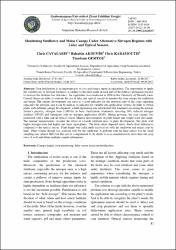| dc.contributor.author | Cavalaris, Chris | |
| dc.contributor.author | Akdemir, Bahattin | |
| dc.contributor.author | Karamoutis, Christos | |
| dc.contributor.author | Gemtos, Theofanis | |
| dc.date.accessioned | 2022-05-11T14:43:38Z | |
| dc.date.available | 2022-05-11T14:43:38Z | |
| dc.date.issued | 2017 | |
| dc.identifier.issn | 1300-2910 | |
| dc.identifier.issn | 2147-8848 | |
| dc.identifier.uri | https://app.trdizin.gov.tr/makale/TWpRek5ETTRPQT09 | |
| dc.identifier.uri | https://hdl.handle.net/20.500.11776/9675 | |
| dc.description.abstract | Crop fertilization is an important part of cost and energy inputs in agriculture. The opportunity to apply the variable rate of nitrogen fertilizers according to the plant needs in each part of the field is a promising practice to increase the fertilizer use efficiency. An experiment was conducted in 2016 in the University of Thessaly farm, Central Greece in order to evaluate the use of lidar and optical sensors to monitor the crop canopy for sunflower and maize. The canopy development can serve as a good indicator for the nutrition state of the crops regarding especially the nitrogen, and it can be used as an indicator for variable rate application systems. In order to obtain plants with different canopy development, a field experiment was established with treatments receiving the normal, farmer's practice, nitrogen rates (100%N) at basic fertilization, treatments receiving 50% reduced nitrogen fertilizer (50%N) and treatments with no nitrogen application (0%N). During growing, the crop canopy was monitored with a lidar and an optical sensor. Manual measurements of plant height and weight were also made. The manual measurements revealed the effect of variable fertilizer rates to plant development. The plots with higher nitrogen rates had higher and more vigor plants. The lidar sensor depicted more clearly these differences compared to the optical sensor. Plant height was sufficiently assessed for both the sunflower and maize crop by lidar. Plant volume though was assessed only for the sunflower. A problem with the lidar sensor was the small sampling rate (almost 2Hz) but this can be compensated by its ability to scan simultaneously more than one crop rows (4 to 6) and obtain multiple sample information. | en_US |
| dc.language.iso | eng | en_US |
| dc.rights | info:eu-repo/semantics/openAccess | en_US |
| dc.subject | Ziraat Mühendisliği | en_US |
| dc.title | Monitoring Sunflower and Maize Canopy Under Alternative Nitrogen Regimes with Lidar and Optical Sensors | en_US |
| dc.type | article | en_US |
| dc.relation.ispartof | Gaziosmanpaşa Üniversitesi Ziraat Fakültesi Dergisi | en_US |
| dc.department | Fakülteler, Ziraat Fakültesi, Biyosistem Mühendisliği Bölümü | en_US |
| dc.identifier.volume | 34 | en_US |
| dc.identifier.issue | 2 | en_US |
| dc.identifier.startpage | 81 | en_US |
| dc.identifier.endpage | 90 | en_US |
| dc.institutionauthor | Akdemir, Bahattin | |
| dc.identifier.trdizinid | TWpRek5ETTRPQT09 | en_US |



















